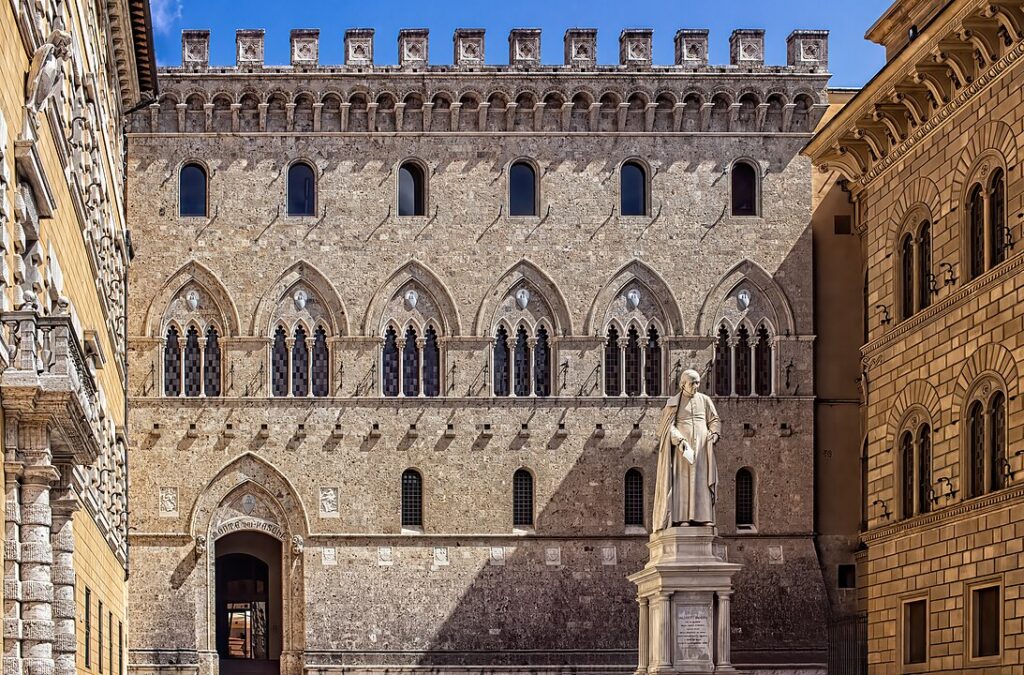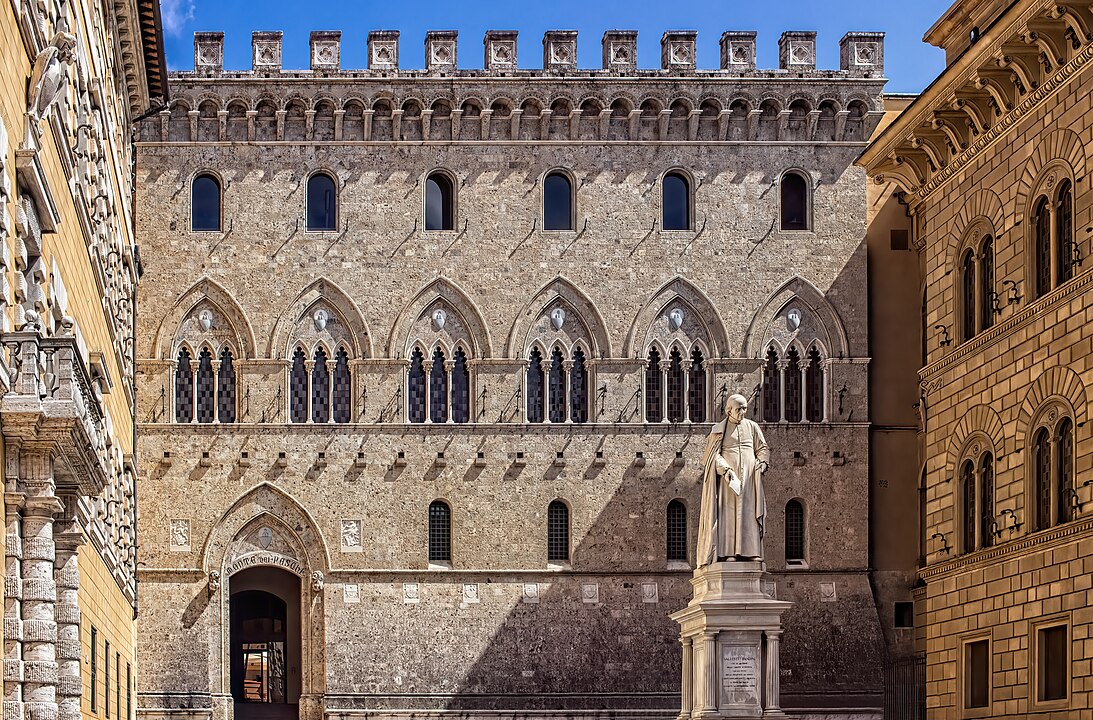“Organized” banking and transactions took place in ancient Mesopotamia (around 2000 BC), where loans were granted to farmers and merchants. Since then, the concept of banking has evolved into the modern banking we know today. Below, we’ll learn who founded the world’s first bank and how the institution has changed over the years.
Oldest bank in the world
As we saw in our previous article, although accounting books were already in use as early as 2000 BC, it was in the temples and palaces of Mesopotamia where the first economic societies began to operate. The first bankers were priests who managed grain, livestock, and precious metal deposits for third parties.
The world’s first bank was the Banca Monte dei Paschi di Siena, which was founded in 1472 in Siena, Italy, by the Magistracy of the Republic of Siena. It is important to note that it still operates with active financial operations today (making it the oldest bank in the world). However, this bank was initially established under the original name of “Monte Pio” as a “Monte di pietà”, a charitable institution designed to provide financial assistance to the needy and combat usury, with the aim of providing loans to the neediest.
Reformation of 1624
In 1624, the Monte Pio institution underwent a significant transformation due to a reform instituted by Grand Duke Ferdinand II de’ Medici. This reform restructured the bank and granted a state guarantee on depositors’ funds. These guarantees came from the income from the state-owned agricultural lands of the Maremma region, known as the “Paschi”, hence the name Banca Monte dei Paschi.
From that moment on, Banca Monte dei Paschi consolidated its position as a financial institution. The reform of 1624 strengthened its financial stability and made it an important part of the region’s financial operations and economic growth, thus becoming a more structured and advanced banking institution.
Restructuring of 1833
The Monte dei Paschi Bank underwent a major restructuring in 1833, which initiated the financial operations of a savings bank. This restructuring represented a major step towards the modernization of the institution, as it demonstrated its ability to expand its operations in financial services, since until then it had only offered traditional loans.
Thanks to this restructuring, the institution was able to play a more important role, helping the economic development of the region, especially in agriculture and public welfare, as well as establishing a solid foundation that allowed it to achieve continuous growth and become one of the most influential financial institutions in Italy.
Corporation of 1995
The institution underwent another significant transformation in 1995, changing from a public limited company to a joint-stock company, which led to its name change from Banca Monte dei Paschi to Banca Monte dei Paschi di Siena.
This transformation meant the creation of a financial corporation consolidated under a modern banking structure, which allowed it to operate with greater flexibility in the financial markets.
Fondazione Monte dei Paschi di Siena
To continue the bank’s charitable functions and due to the creation of the corporation in 1995, the Fondazione Monte dei Paschi di Siena Foundation was created, with Banca Monte dei Paschi di Siena as its largest shareholder, thus separating the banking operations of both entities. It is important to note that the foundation continues to operate today, supporting the economic, social, and cultural development of the Italian region of Siena.

Listed on the “Borsa Italiana” in 1999
Thanks to its transformation into a public limited company, Banca Monte dei Paschi di Siena was able to consolidate its position in the Italian banking sector. The creation of the corporation in 1995 was an important step in Banca Monte dei Paschi di Siena’s modernization and laid a solid foundation for the bank’s next major step: its listing on the Borsa Italiana (Italian Stock Exchange) in 1999. Listing on the stock exchange allowed the bank to expand its financial operations and attract new investors.
Financial crisis 2013
The bank faced a serious financial crisis in 2013. This problem began when the corporation acquired Banca Antonveneta at a higher-than-quoted price (inflated price) in 2007, which weakened its balance sheet that year.
It was then that, in 2013, the bank became embroiled in a scandal involving risky derivatives contracts, which intensified the crisis as significant losses stemming from these contracts were revealed. To stabilize its finances, Banca Monte dei Paschi di Siena received a €3.9 billion government bailout in the form of state aid to prevent collapse.
However, due to the necessary financial restructuring and efforts to comply with regulatory requirements, the institution continued to face financial difficulties, which is why it required a new intervention in 2017, but this time by the European Commission, which, seeking to achieve the stabilization of the bank, approved a preventive recapitalization of 8.1 billion euros.
Financial recovery
Following the recapitalization offered by the European Commission in 2017, Banca Monte dei Paschi di Siena has undergone several major transformations. It is estimated that between 2017 and 2022, in order to maintain financial recovery, clean up its balance sheet, and stabilize operations, the institution received more than 10 billion euros.
Privatization
We must remember that, since the government support in 2013, Banca Monte dei Paschi di Siena has a 64% state control, however, in 2023 the Italian government announced the sale of 20% of its stake, which meant a reduction to 44%, which allowed the entry of more private investors, promoting the partial privatization of the institution.
News from the Monte dei Paschi di Siena Bank
During 2024, Banca Monte dei Paschi di Siena enjoyed several favorable factors. For example, it was able to begin operations with greater freedom as the European Central Bank lifted its restrictions on profit distribution. Furthermore, the Italian government moved forward with selling more shares, reducing its control to 11.7% thanks to the participation of Banco BPM and other private investors. This has allowed Banca Monte dei Paschi di Siena to consolidate its position in the Italian banking sector.
What do you think about this topic? Would you like to learn more about the world’s first bank?
If you are interested in Pilsenga products or services (including online banking for businesses), you can contact us by visiting the following link.
Image by Ray in Manila via Wikimedia.org under creative commons license.
